ThrustMaster was formed in 1990 by Norm Winningstad, and was headquartered in Hillsboro, Oregon.
They are probably most famous in the DOS era for their expensive but excellent Weapons Control System (WCS) and Flight Control System (FCS) peripherals.
The company was acquired by Guillemot Corporation in July 1999, who had also bought Hercules Computer Technology the same year. With the two they merged into a new company called Hercules ThrustMaster, and had their headquarters in Carentoir, France. They continue operating to this day designing and manufacturing joysticks, game controllers and steering wheels for PC and consoles.
 Flight Control System (FCS) Flight Control System (FCS)
Launched: 1992
Interface: 15-pin game port
Axis: 3
Buttons: 3
Hat Switches: 1
Price: £170?
In 1992, Thrustmaster released the Flight Control System, often abbreviated to FCS. It was the first true flight yoke available for the PC.
Digital commands from the FCS/WCS MK1 are sent through the keyboard interface while the game port handles the analog joystick inputs. The original versions used a non-programmable PROM for the keyboard commands. Later on, they sold a chip to make it into a programmable EEPROM, so programs could be written and uploaded to the WCS.
"With the ThrustMaster system, though, you can approximate a true HOTAS setup.
The ThrustMaster system consists of two components, each sold separately: the Flight Control System (FCS) joy-stick and the Weapons Control System (WCS) throttle. The FCS is probably the most authentic control stick available for any computer. Its heavy-gauge molded plastic stick looks just like the sidestick in an F-16. It has four buttons (the extra buttons are currently supported by Falcon 3.0, where they toggle speed brakes and change weapons modes, and by Chuck Yeager's Air Combat 1.1) and uses a unique nonlinear spring system to provide more tension as you push the stick farther--just like in a real plane. It has no trim adjustments, however, so it's only suitable for flight simulators that let you calibrate the stick within the program.
The WCS is a throttle control with six buttons and a three-position toggle switch. The throttle works just like a side throttle in a fighter jet: Push the throttle forward to the detente stop to go to full speed; push it farther to activate afterburners. The buttons and toggle switch activate different functions, depending upon which simulator you're using. In Falcon 3.0, the buttons control flares, chaff, target selection, lock on, lock clear, the air brake, and combat mode. In Secret Weapons of the Luftwaffe, on the other hand, they control the gun camera, map mode, weapons mode, arming and launching rockets, flaps, and landing gear. Be prepared for a bit of confusion if you fly a number of simulations, but it's no worse than memorizing different keyboard controls.
The WCS acts as a keyboard device and plugs in between your PC and its keyboard. (Note that you'll need adapter cables if you have a PS/2-style keyboard). It works by sending the key codes to the computer as if you'd pressed them on the keyboard. This works great for weapons toggles and such, but the WCS sends throttle movements by sending keypresses, also. This isn't as responsive as the analog throttle control used by the CH FlightStick and Thunderstick. Also, some programs, such as Secret Weapons of the Luftwaffe, can't accept a fast series of keypresses, so quick throttle movements can result in little more than a series of "too-many-keypresses" beeps.
Because the WCS has to send different keypresses depending on which simulator you're running, you have to change a set of DIP switches on the back of the case each time you boot a different simulator. You also must replace a ROM chip inside the stick to add support for new programs. The stick currently supports 14 of the hottest flight simulators--including Falcon 3.0, Chuck Yeager's Air Combat, Wing Commander, and A-10 Tank Killer--and the ThrustMaster company regularly releases updated ROMs for a small fee. Even with these minor problems, though, I'd recommend the WCS to all flight sim fans, no matter which joystick you choose. With a good joystick in your right hand, the WCS in your left, and a set of rudder pedals at your feet, you've got a true HOTAS system that can make combat easier, more realistic, and much more exciting."
Compute!, May 1992
The FCS was directly supported by over 130 games titles.
More Images
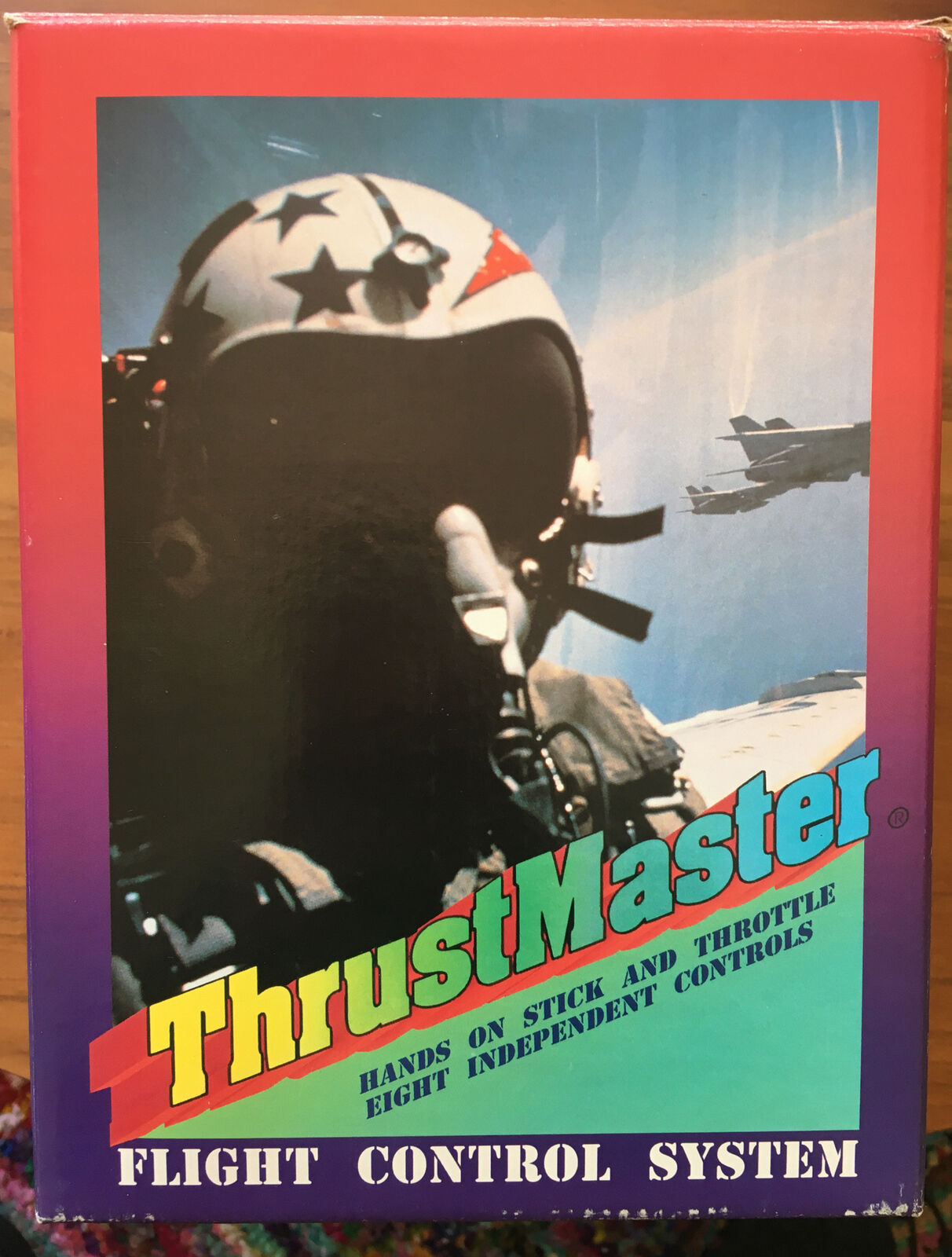 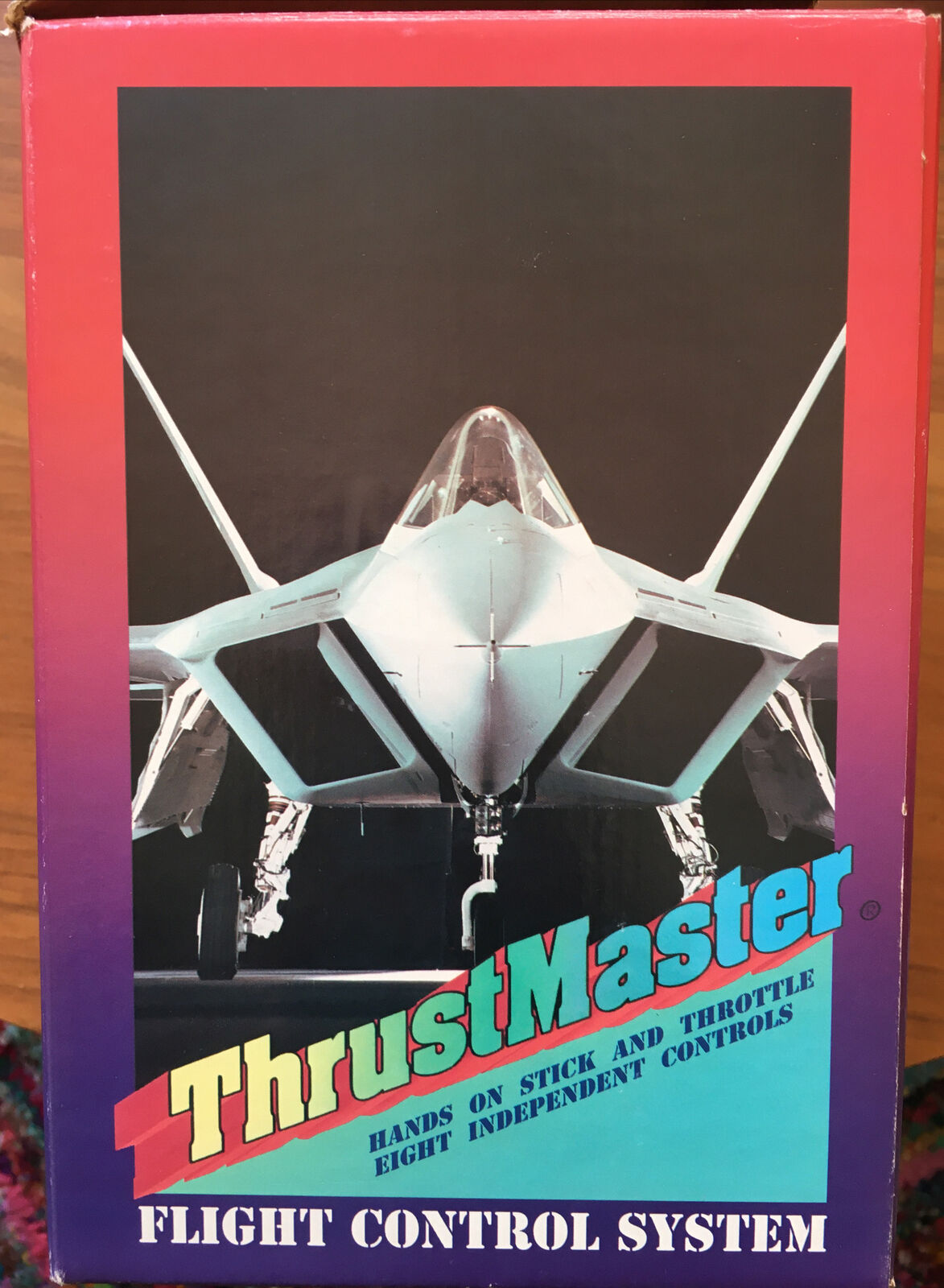 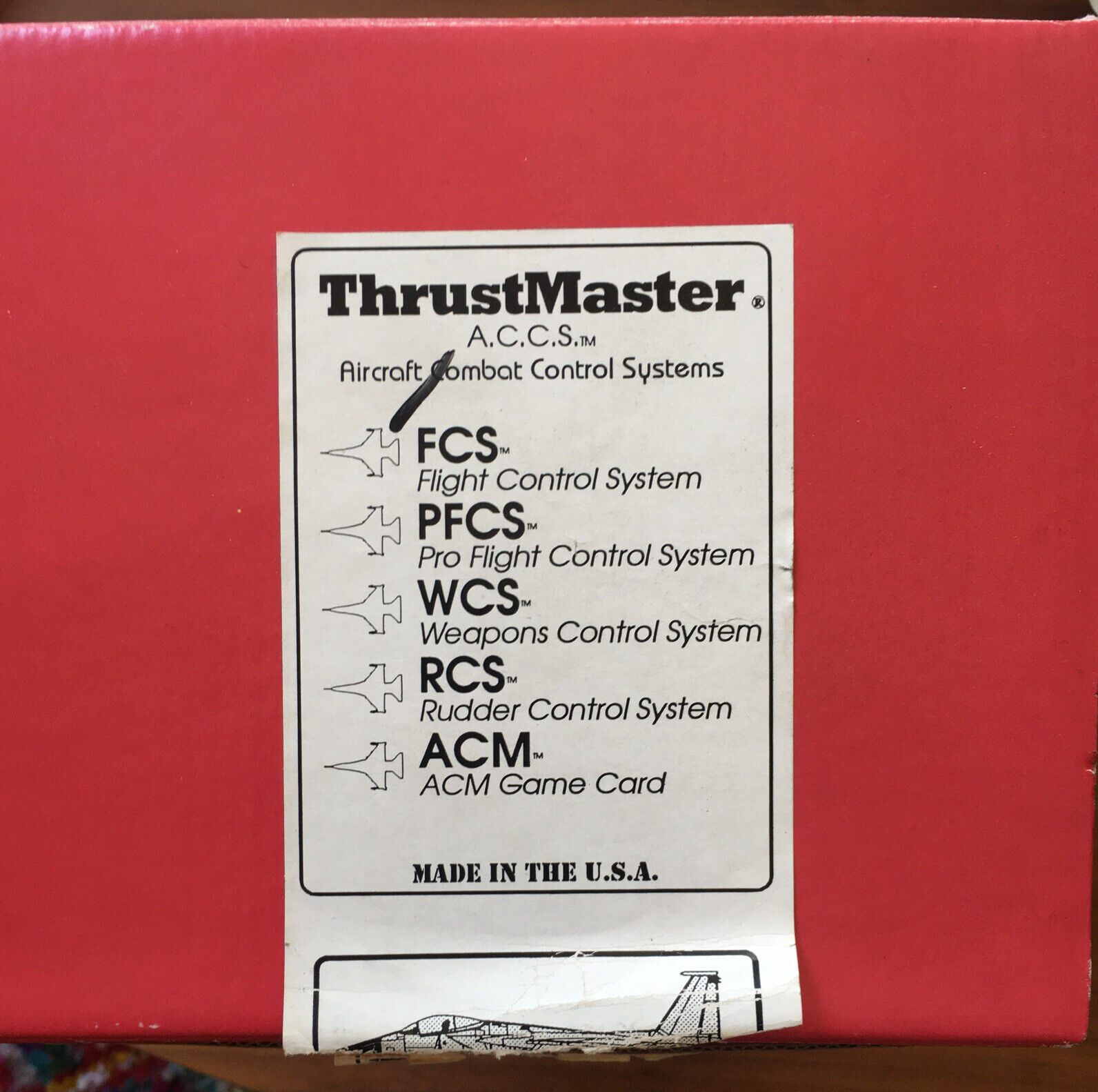 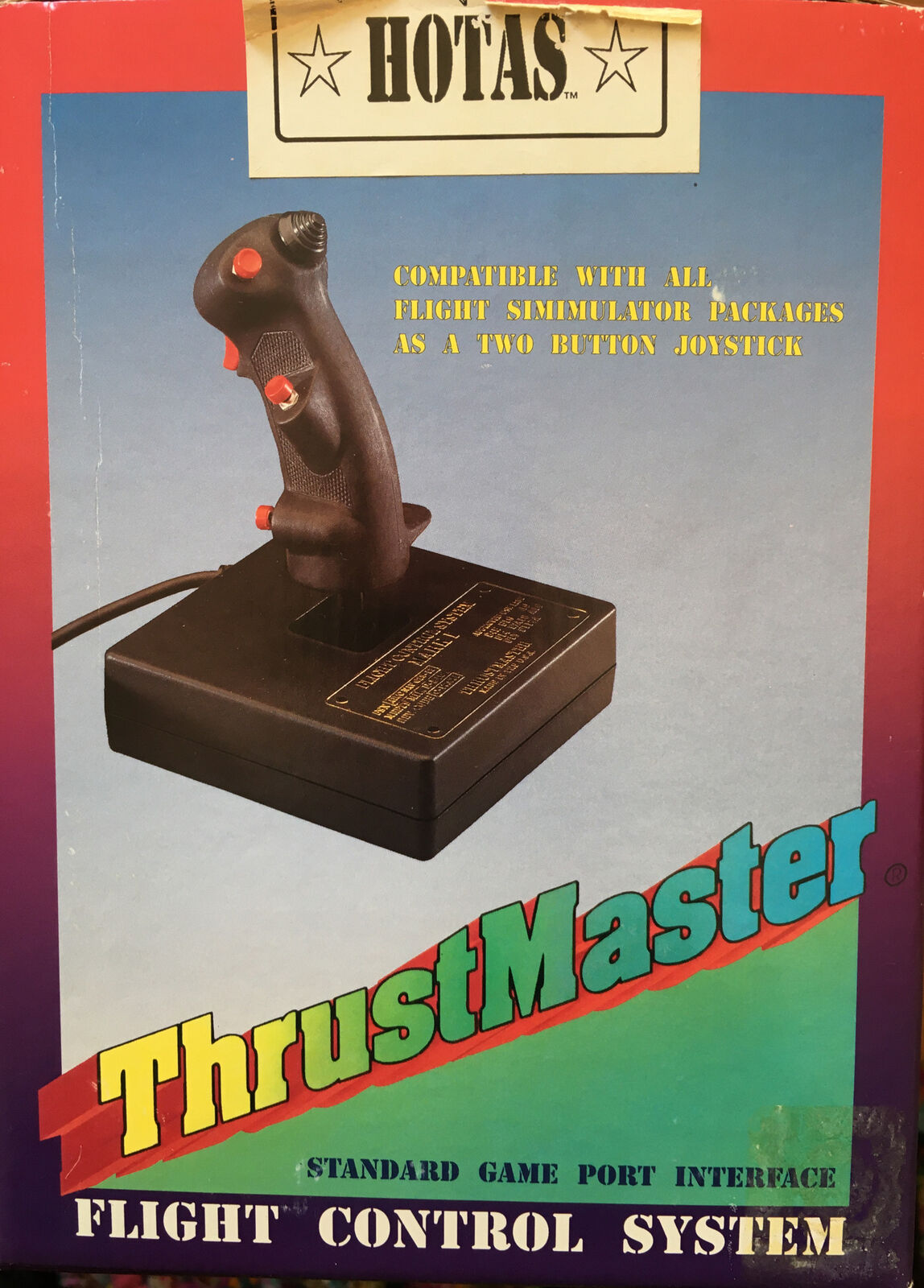 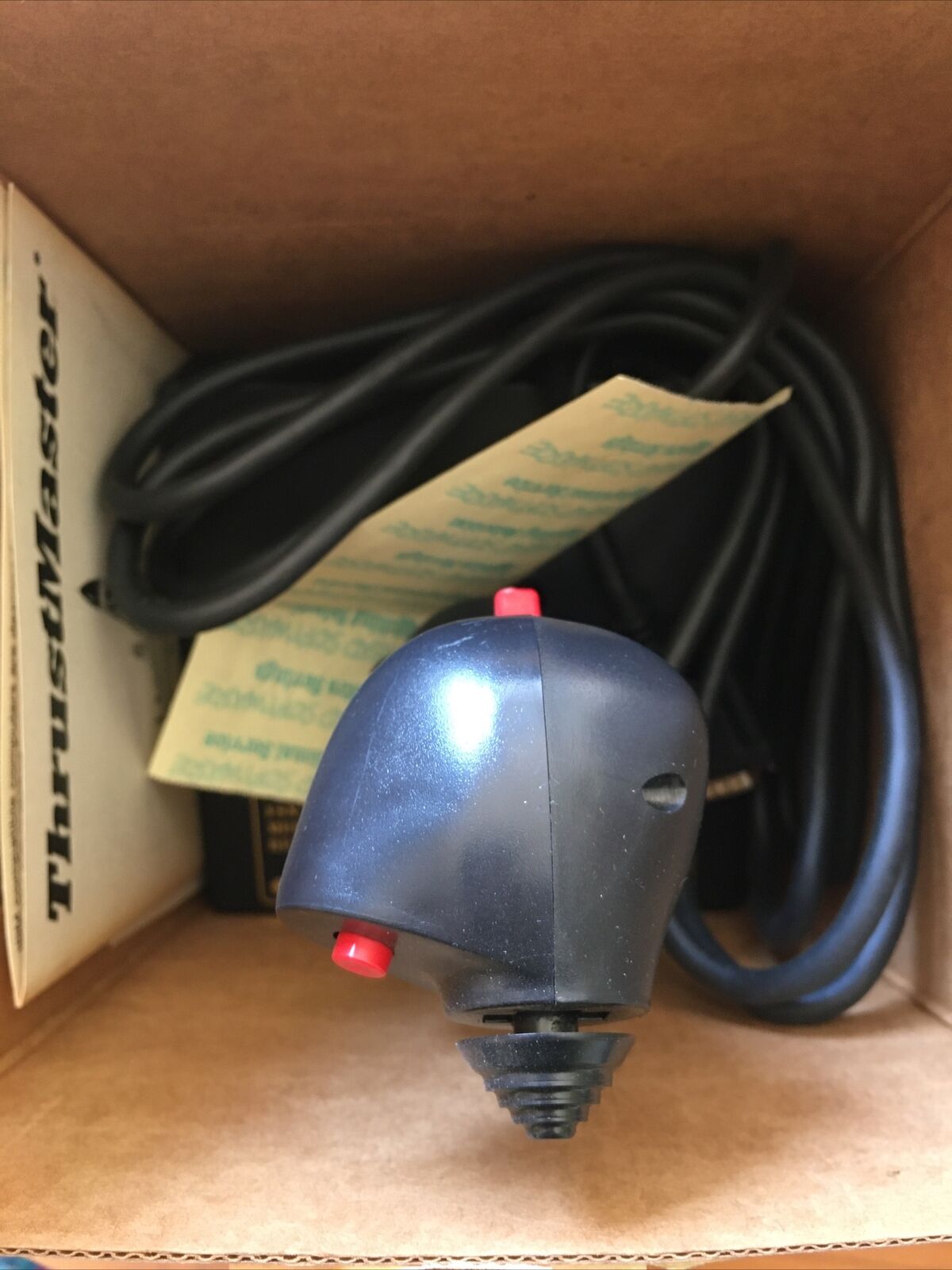 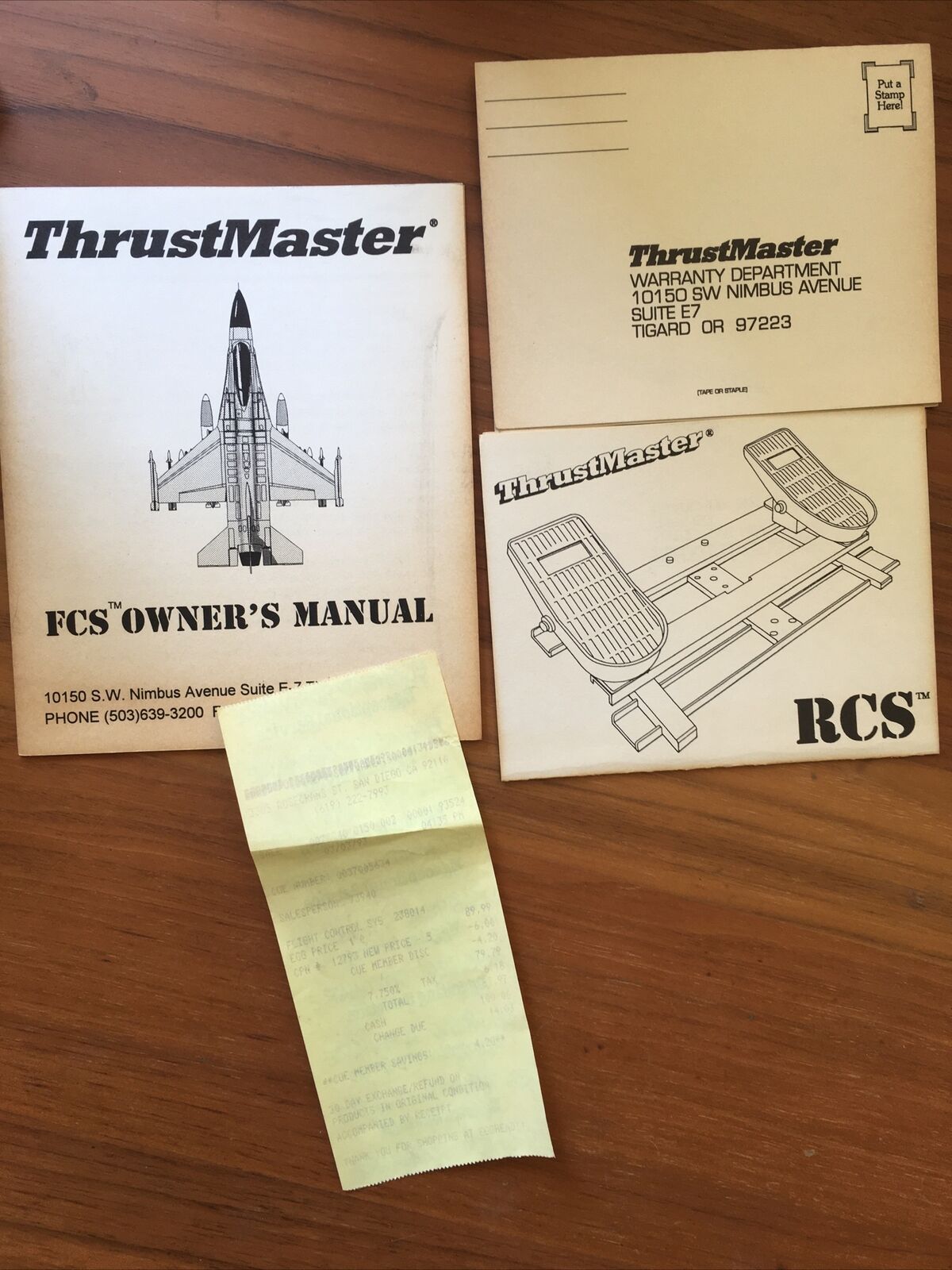
|
 Weapons Control System (WCS) Weapons Control System (WCS)
Launched: 1992
Price: $79 (Nov 1992), $76 (Dec 1992)
In 1992, ThrustMaster released the Weapons Control System, often abbreviated to WCS. This complemented the Flight Control System (FCS) perfectly, and provided both a throttle control and weapons control for the other hand, all on one device.
See the review from Compute! further up, which also covers the WCS.
More Images
|
 Rudder Control System (RCS) Rudder Control System (RCS)
Launched: 1992
Interface: 15-pin game port
Price: $149.95 or £116 (when new), $109 (Nov 1992)
"Now there is a middle-ground alternative: the Rudder Control System from Thrustmaster ($149.95). The company is well-known for its joysticks and Weapons Control System, which are popular with the combat crowd, but the rudder pedals are likely to be a hit with all flight sim fans.
The assembly is made of gold-anodized aluminum beams, with two large black plastic foot cups mounted a comfortable 12 inches apart. The unit weighs 5.5 pounds and has 6 rubber feet., which help it stay put when you're practicing your barrel rolls or Immelmann turns.
The Rudder Control System connects to the computer's game port. A two-headed cable allows you to connect a joystick or flight yoke as well. The pedals are compatible with Microsoft Flight Simulator and many other programs.
If you're looking for one piece of hardware that can make a significant improvement in your computer flying experience, but at a price that won't break the bank, the Thrustmaster Rudder Control System is a top-flight choice."
TLM, PC Magazine, July 1993
The Rudder Control System was succeeded later by the Elite Rudder Pedals. |
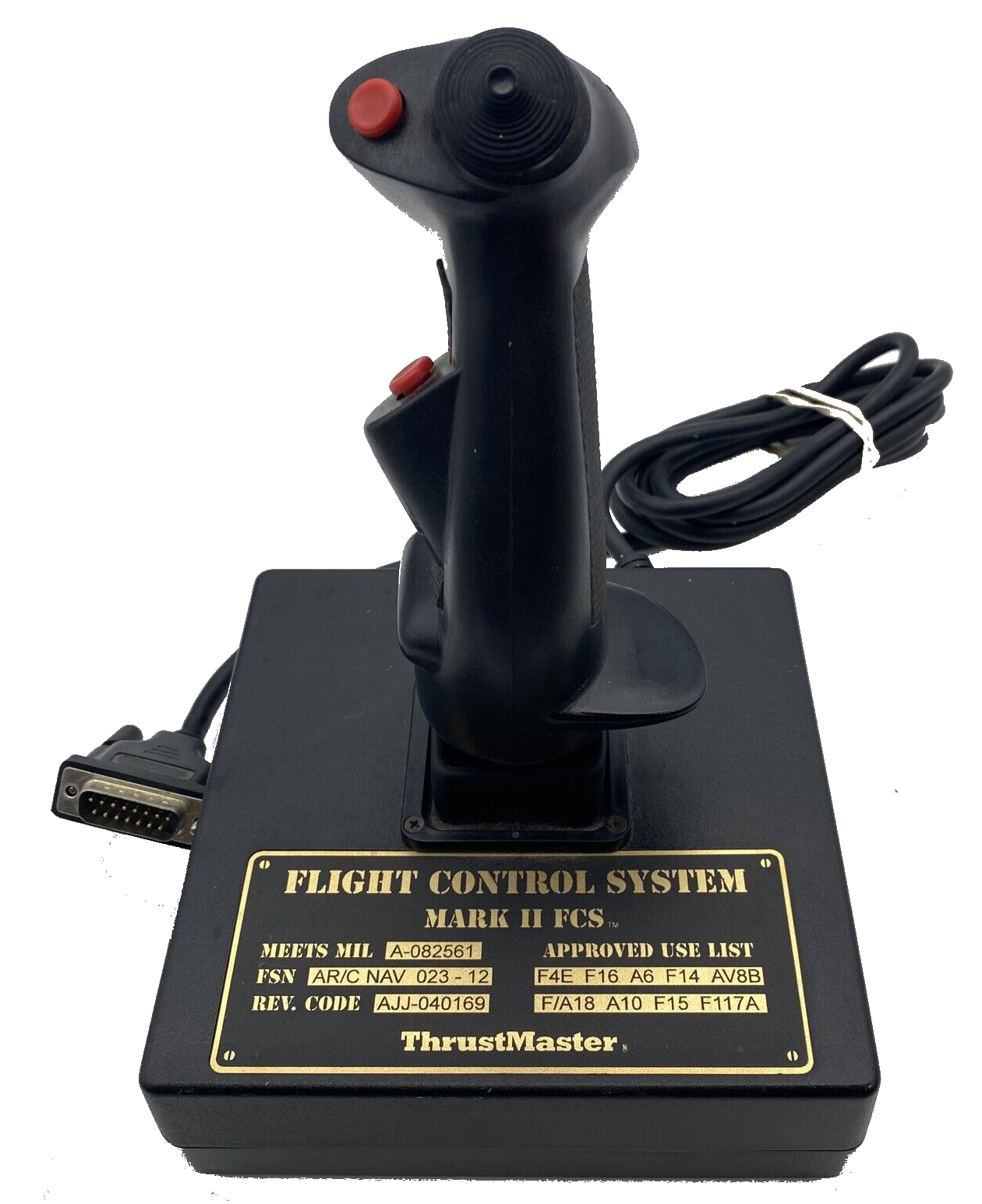 Flight Control System II (FCS II) / Pro Flight Control System (PFCS) Flight Control System II (FCS II) / Pro Flight Control System (PFCS)
Launched: 1993?
Price:
The FCS II, like the original, is still modelled on a scaled-down replica of the F-4 Phantom stick. Differences from the FCS are that this one now has a rubber boot around the base of the stick to keep dust out, better quality switches, and stiffer springs. According to the manual:
The PFCS is also compatible with the Mark II WCS from ThrustMaster. When your PFCS is plugged into the Mark II WCS you can program the Hat Switch and all buttons on your PFCS. This will allow you to use all the functions of the PFCS with any software program.
"DESIGN INTENT
The PFCS was designed to replicate the forces you would feel if you were flying a real jet fighter aircraft. In fighter aircraft, such as the F/A-18 and the F-16, control of the aircraft is stabilized for the pilot. This means that the pilot has to input a progressively greater force on the stick in order to gain a larger angle of attack (AOA) and command a larger G force.
Stick forces required in the F-16, for example, are as follows: Maximum roll rate - 17 lbs, Maximum pitch up - 25 lbs, Maximum pitch down - 16 lb.
The ThrustMaster PFCS approximately equals these forces. This will assist you in not 'overcontrolling' the aircraft. You then remain in control of your jet, taking control of the fight rather than allowing the bandit to set the pace of the battle.
The PFCS avoids this pilot-induced overcontrol situation by using the pilot's subconscious to remind him, through stick forces, how far and how fast he is moving his joystick, thus allowing the pilot to remain in control of the simulator. In addition, the potentiometers, the finest available on the market today, are gear-driven (in the PFCS) which makes the PFCS the smoothest joystick in terms of response.
Typically, we have found that a new user, unfamiliar with a stick like the PFCS will require about two weeks to get used to the higher stick forces required with the PFCS. After two weeks time, the usual comment we hear from a new user is that they can no longer fly properly with an arcade-type joystick. It takes time to get used to anything that is new.
With the PFCS, for the first time, you can fly like the real fighter pilots. They keep their eyes on the bandit at all times, anticipate his moves and then fly their aircraft to a point in the sky where the bandit will be based on what they observe the bandit doing. The PFCS will give you "subconscious" feedback of the amount of force you are placing on the stick, this eliminates the need to constantly ram your stick from end to end while turning control of the fight over to the bandit.
Weaker tensioned springs require the pilot of a simulator to constantly move the joystick all the way from one end to the other. This results in the aircraft becoming in control of the pilot rather than the other way around. You can spot this type of control behavior if you watch a flight simulator pilot flying and you see that his joystick is consistently held in the extreme limits of travel while chasing a bandit. This is known as 'following the bandit'."
PFCS Manual
More Images
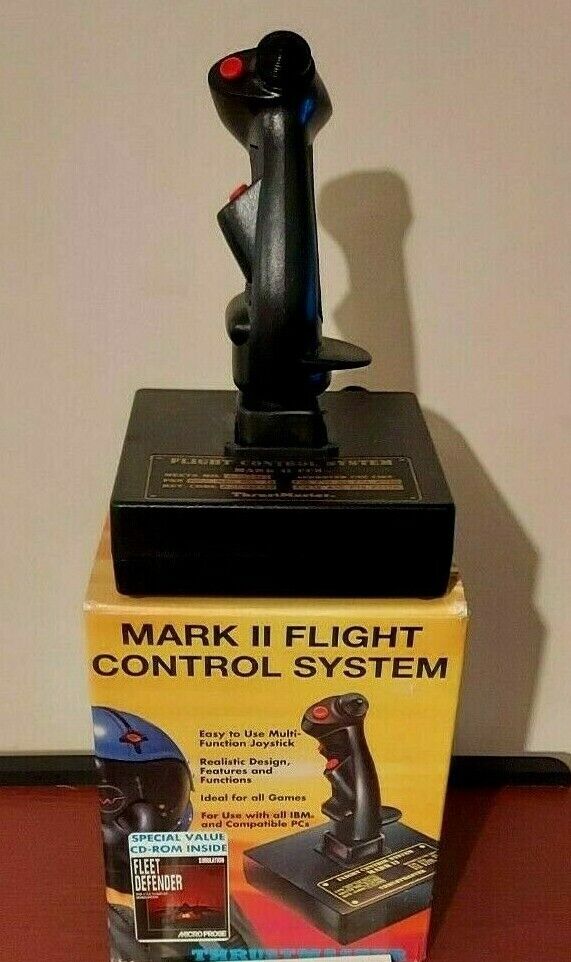
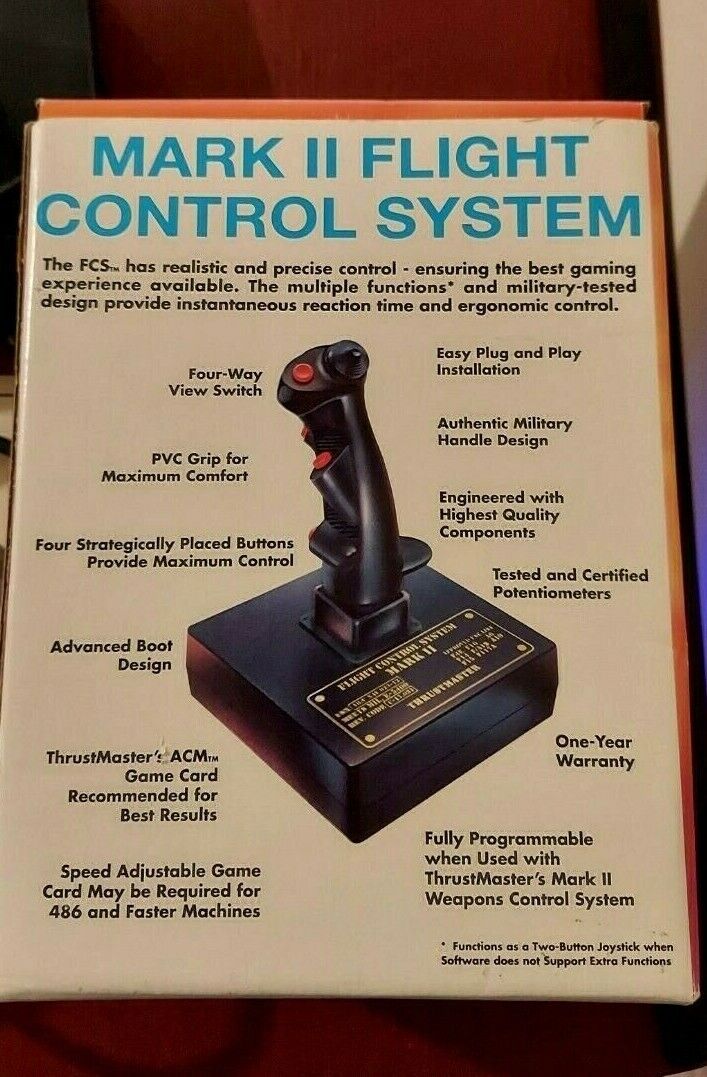 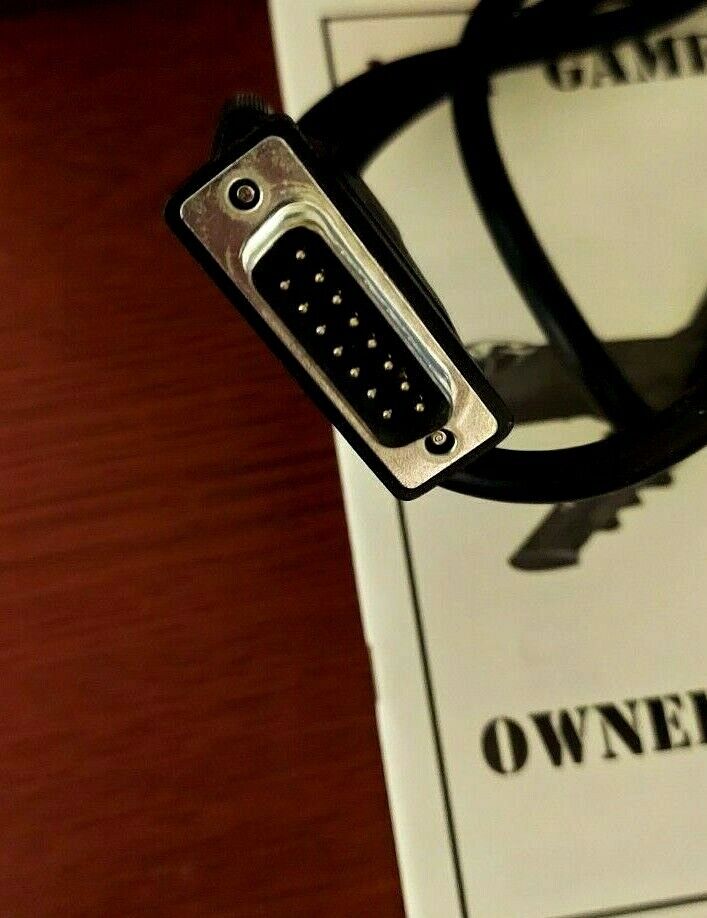  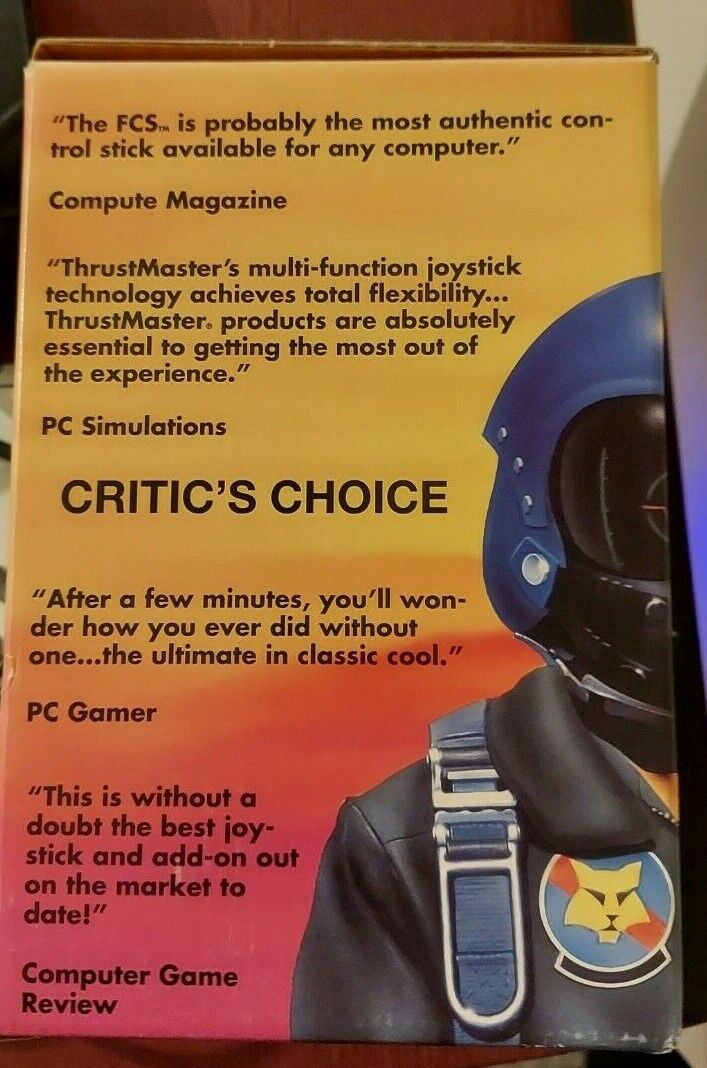 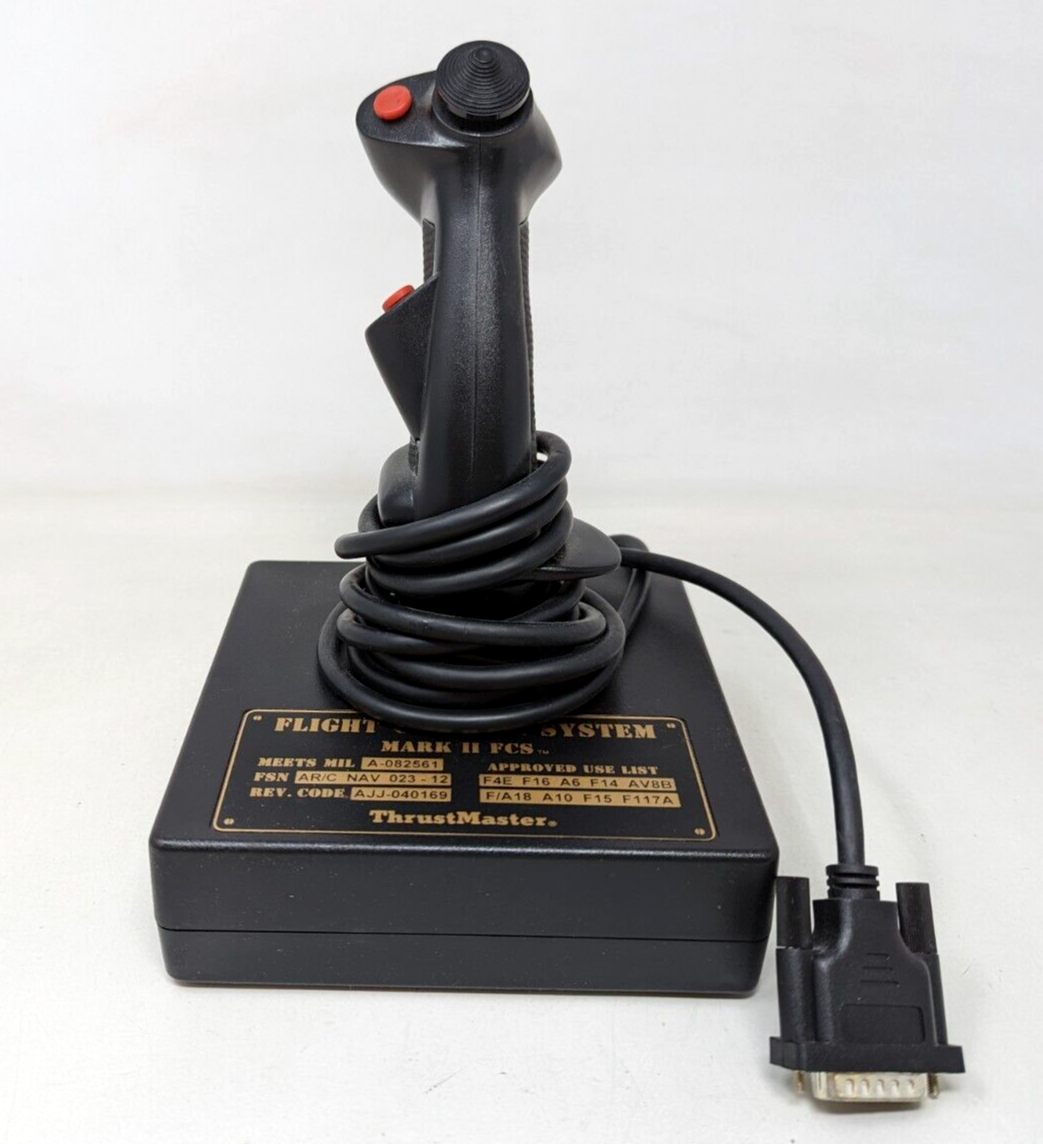 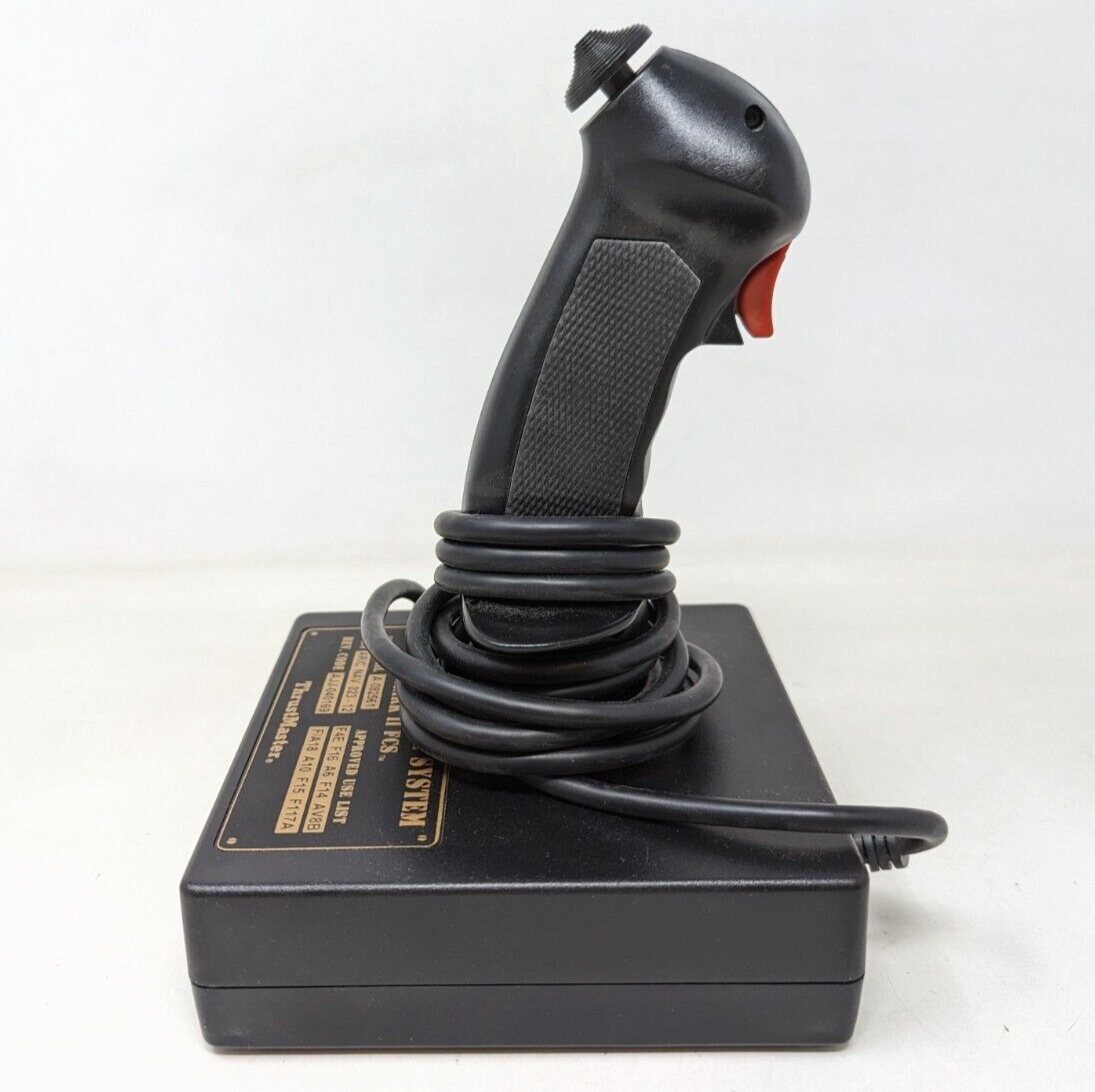 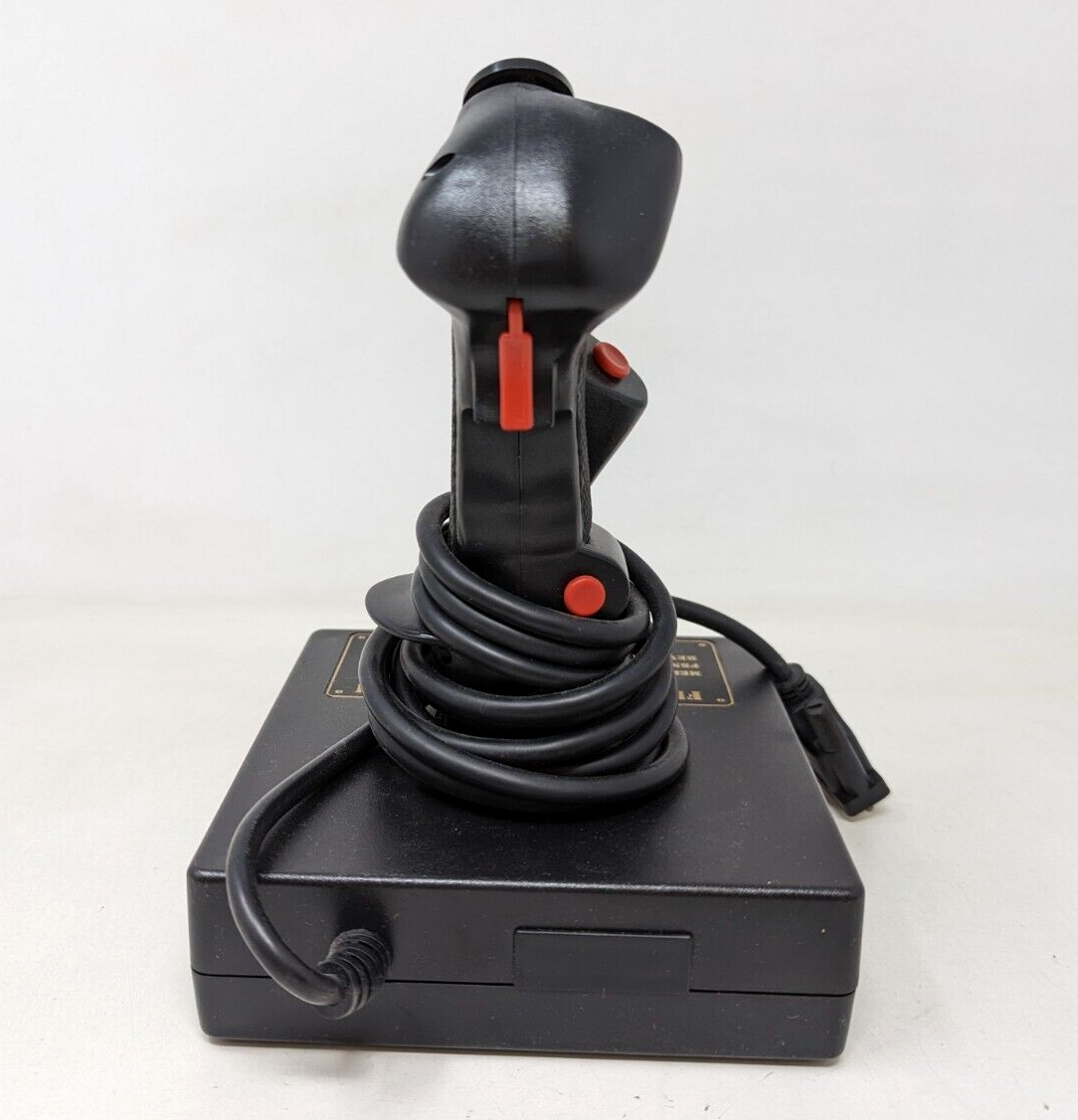 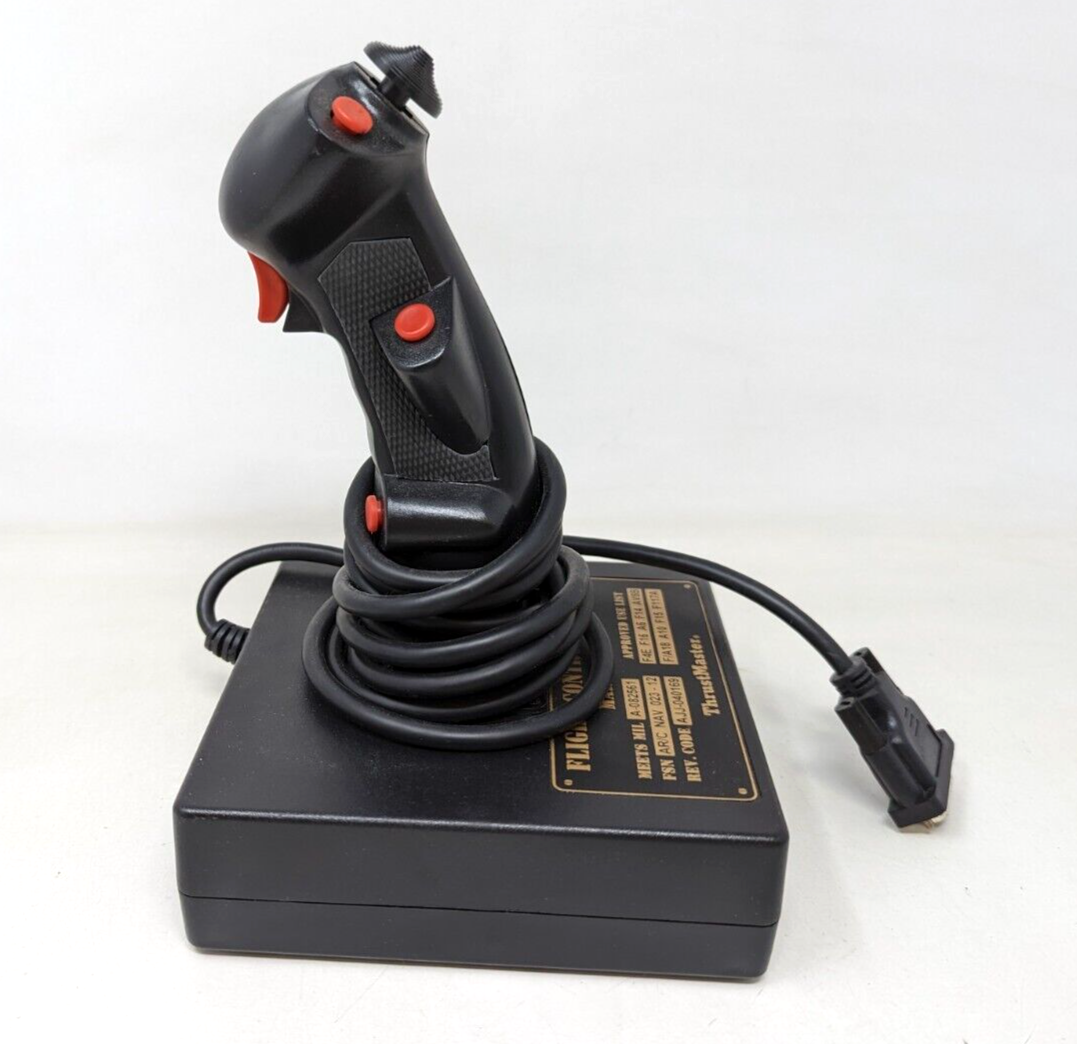 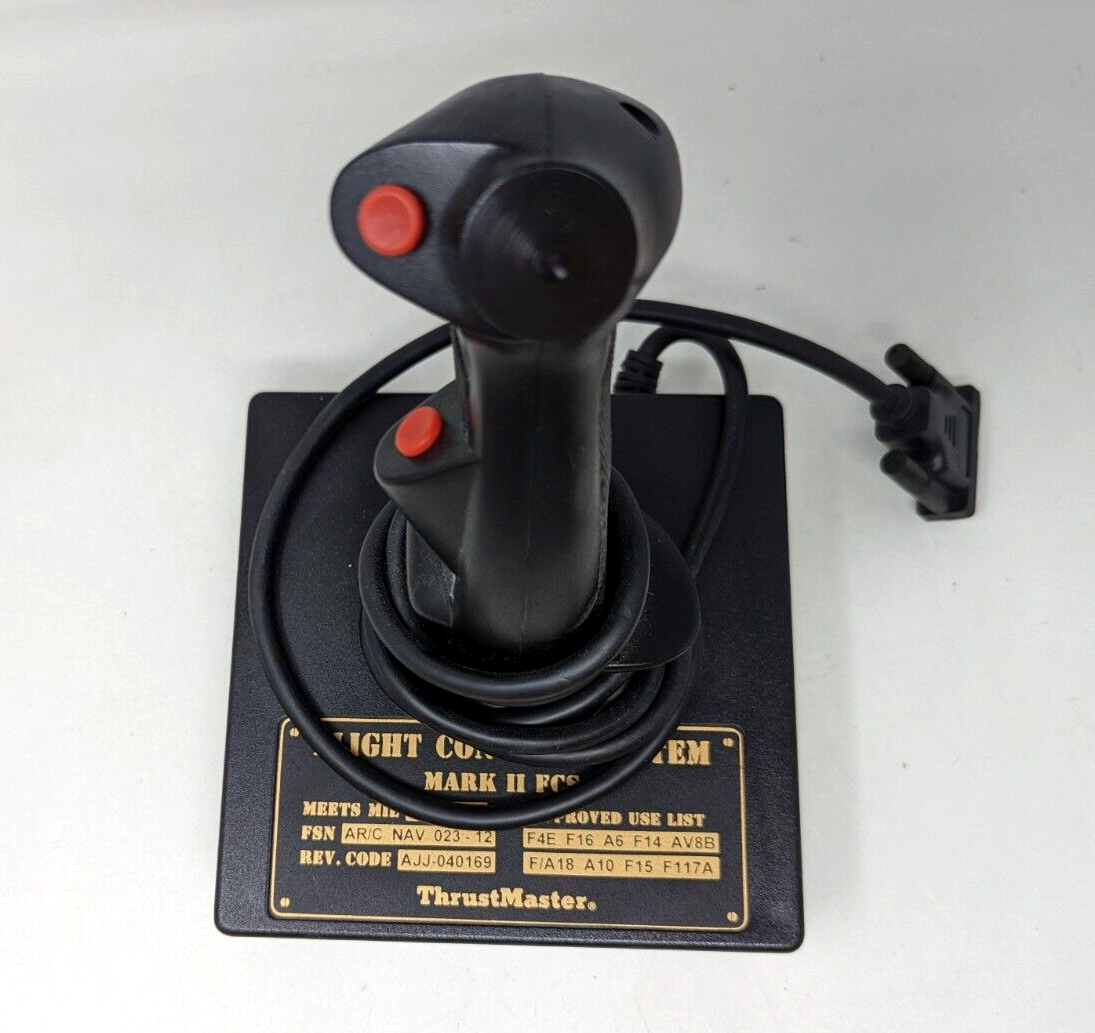  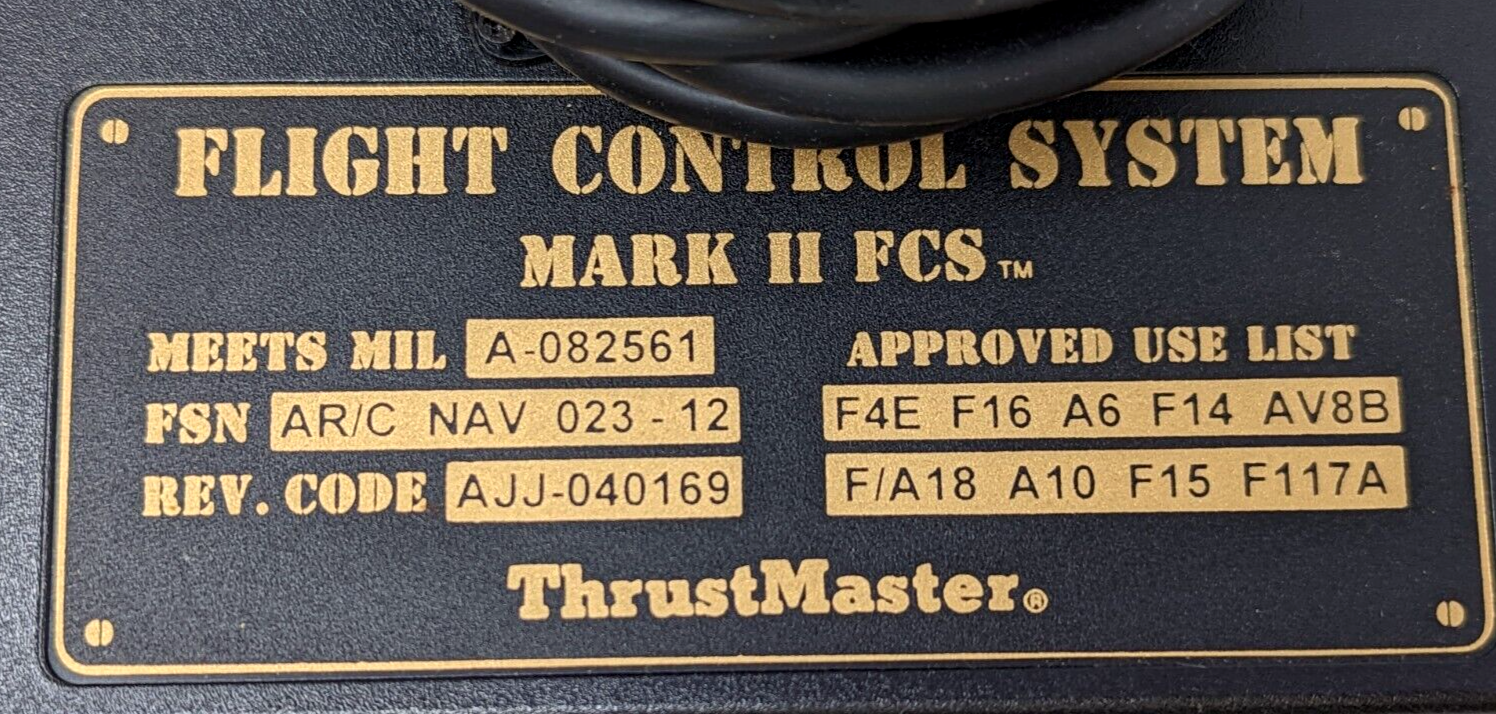 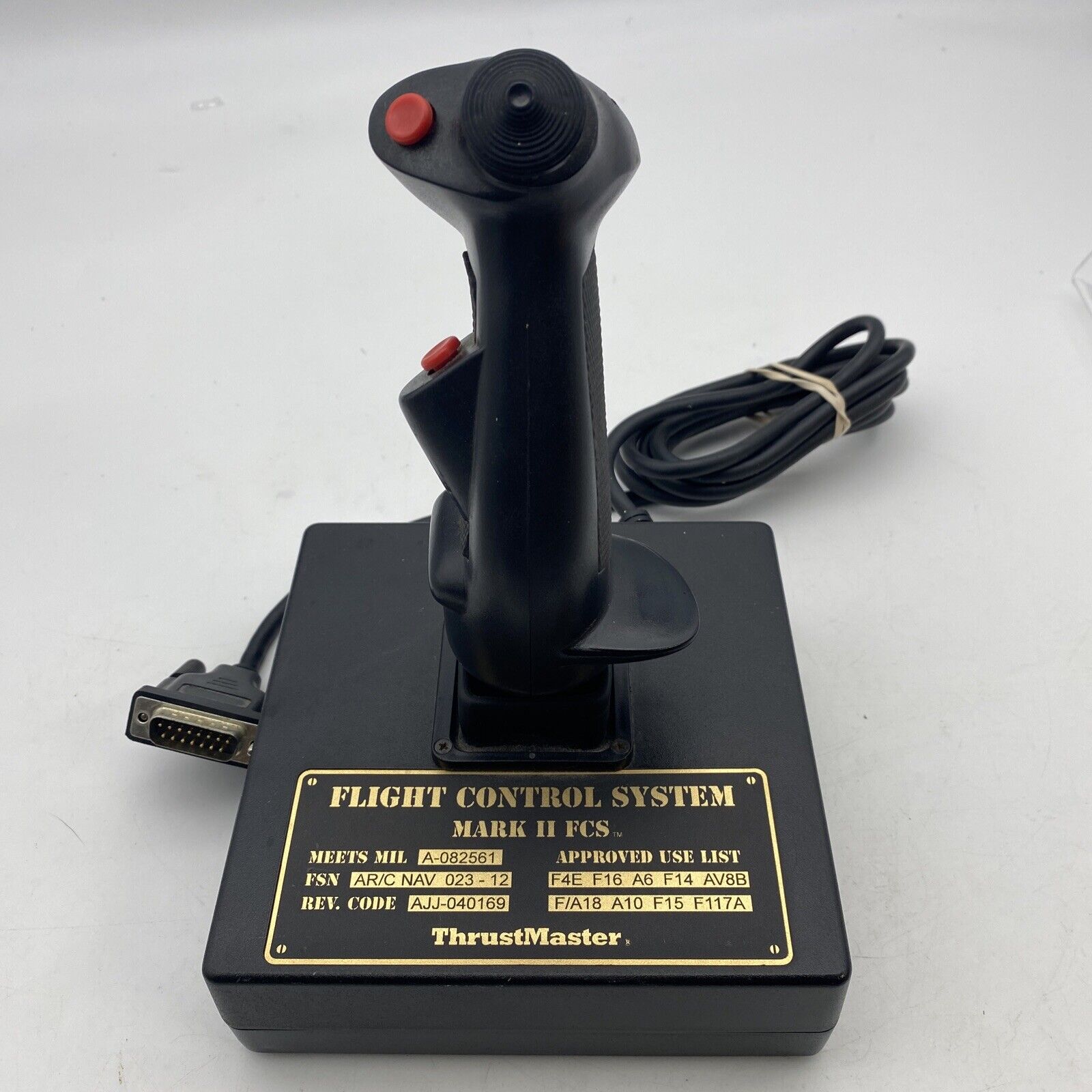
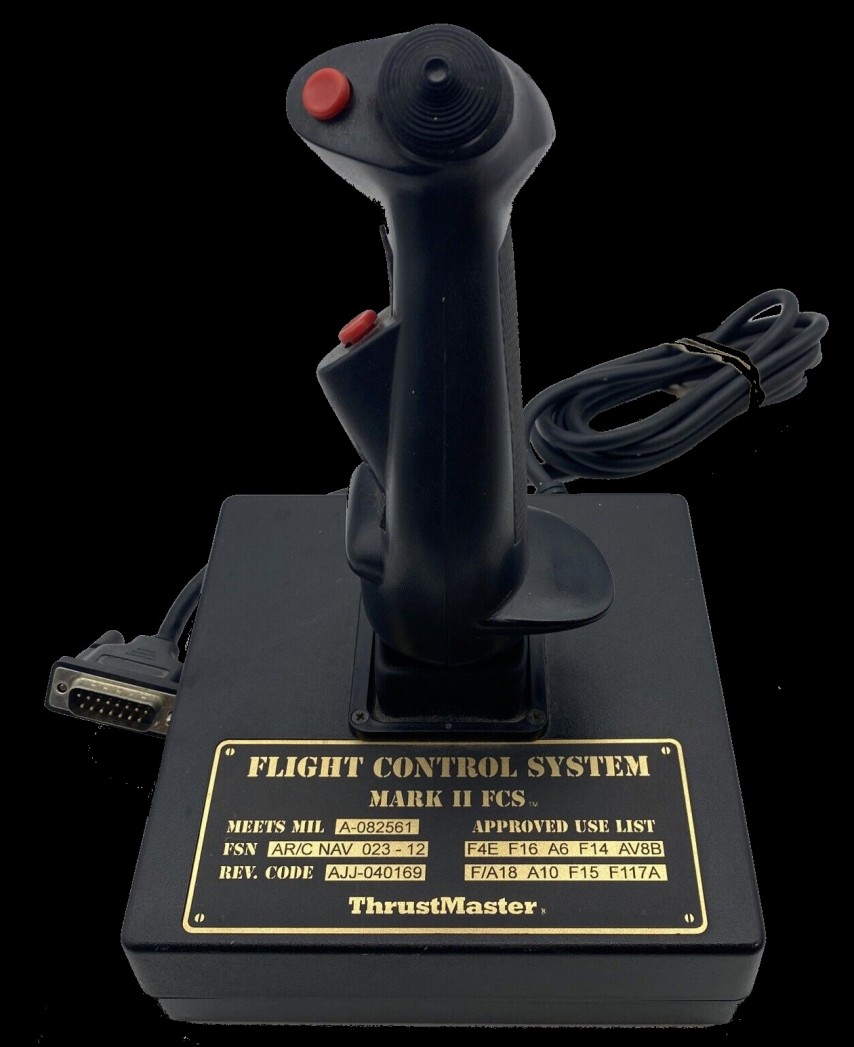
Some images courtesy of Len H
|
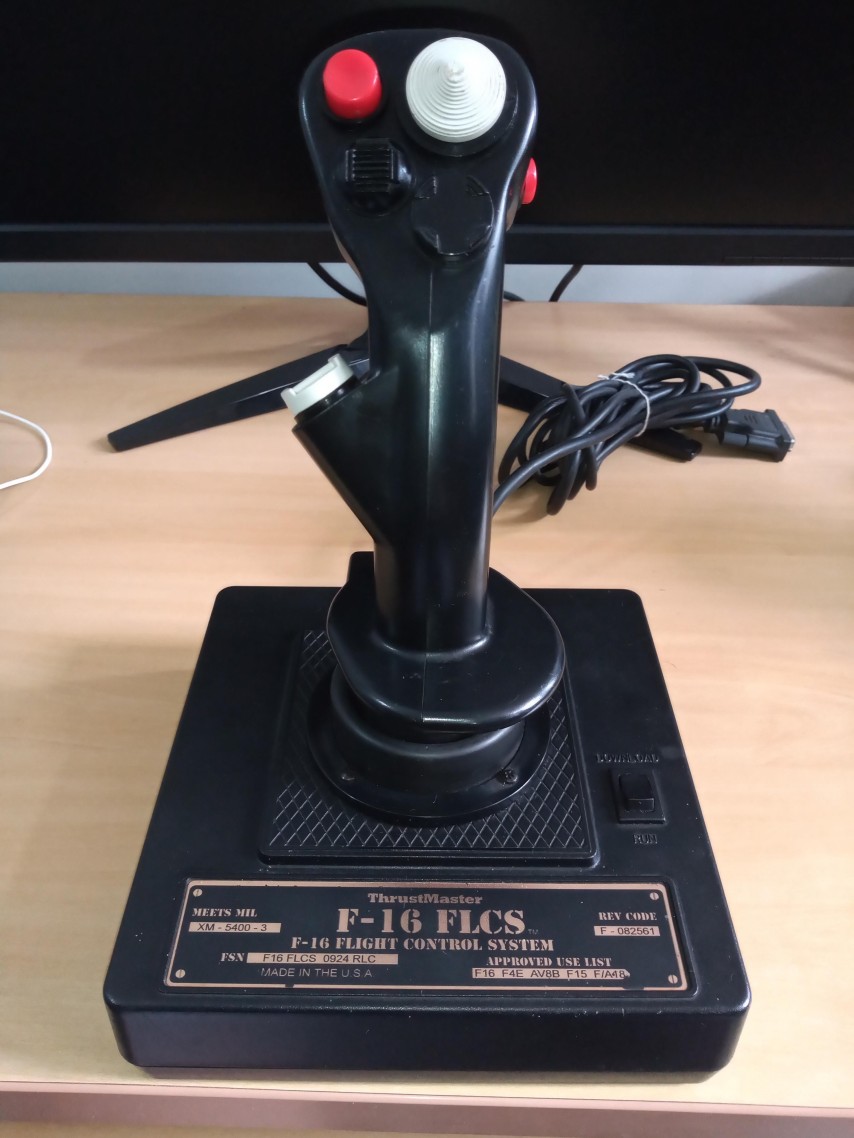 F-16 FLCS Flight Control System (FCS) F-16 FLCS Flight Control System (FCS)
Launched: 1994
Interface: 15-pin game port
Price: $
The F-16 FLCS has these features:
- Heavy cast zinc gimbals with delrin bushings
- Seamless heavy gauge steel and aluminium base
- Brass and nickel hardware
- Hard urethane coated base
- 100% glass-filled nylon handle
- Aluminium reinforced nylon shaft
- Extra stiff spring tension
- Top quality potentiometer and switches
- Four 4 way switches
- Fully programmable
"Thrustmaster's original joystick, the FCS (Flight Control System), was modeled after the flightstick found in the workhorse of the Korean and Vietnam wars - the F-4 Phantom fighter jet. But with new combat simulations come new planes and new joysticks. One of these new joysticks, the F-16 FLCS Flight Control System, caters to combat-jet simulation fans who flock to the temple of F-16 simulation: Falcon 3.0.
As its name suggests, the F-16 FLCS is modeled after
the flightstick in the F-16C Falcon, one of the most maneuverable and deadly fighters in the world. The F-16 FLCS, which plugs into the keyboard and joystick ports, features four buttons, a dual-stage trigger, and four eight-way toggle hat buttons. All of these controls and in an ergonomic design that's been tested by combat veterans - the real ones, not just VGA jockeys.
Unlike the original FCS, this joystick
does not require direct game support or TSRs, making it far more flexible. Each button on the F-16 FLCS is user-programmable, so you can set buttons either to emulate keystrokes or to function as standard joystick buttons. The customization process is somewhat complex but can be avoided by using the included preconfigured joystick settings; they cover virtually all simulation software and other popular games (such as DOOM).
The multitude of toggle switches
and buttons might be intimidating at first, but it pays to persevere."
PC Magazine, December 1994
A Limited Edition was created consisting of 5,000 units. Each each was one serialised and signed by Maj. Gen. Joe H. Engle (Ret), Lt. Col. Robert L. Shaw (Ret) - (NOTE: author of Fighter Combat - Tactics and Manoeuvering by Robert Shaw) - and Capt. Buzz Hoffman (Ret). It retailed for $499.95.
Image above courtesy of Len H.
F-16 FLCS Software from Thrustmaster |
 Elite Rudder Pedals Elite Rudder Pedals
Launched: 1996?
Price:
The newer Elite Pedals look to be more compact than the originals.
Features:
- fore and aft movement
- spring-loaded pivot action
- heavy ABS construction
|
 Phazer Pad Phazer Pad
Launched: 1997
Price: $69.99
Axis: 2
Buttons: 12
"Though highly successful the the high-end flight-stick market, Thrustmaster has had problems in the more general controller arenas. The Phazer Pad doesn't figure to change this trend.
The Phazer is the second-largest game pad we reviewed. It is also the busiest, with four main buttons on top, two flipper buttons on the front, two triggers underneath the flippers, separate start and select buttons, two mode
switches, and a throttle control. We found this arrangement overwhelming.
When we limited ourselves to the directional pad and the four main buttons, we like the Phazer Pad a lot. It's very responsive, and we found the directional pad and buttons comfortable. The pad works well under Windows 95 and DOS and is fully programmable under both.
We did not like the amount of time it took to download a new set of custom commands into the pad, however (nearly 2 minutes for FX Fighter Turbo).
We also did not like the fact that the Phazer Pad plugs into the keyboard port and the game port. Particularly on PCs with DIN keyboard ports, the Phazer's snakelike array of plugs becomes annoying.
With some minor improvements, fewer buttons, and a lower price, the Phazer Pad would be a top-notch controller. As it stands, though, this pad is no match for the GamePad Pro."
MER, PC Magazine, May 1997
|
 Weapons Control System II (WCS II) Weapons Control System II (WCS II)
Launched: 1997
In 1996, Thrustmaster released their successor to the original WCS. This has coloured LEDs on the left which indicated the status of the rocker switches.
The last set of drivers for the WCS II were for Windows 95OSR 2, dated
|
 X-Fighter X-Fighter
Launched: 1997
Interface: 15-pin game port
"If you've always wanted a Thrustmaster-quality joystick but were unwilling to shell out $150 to $200, there are now two alternatives. Thrustmaster has taken the basic design of its high-end Pro Flight Control System (PFCS), which retails for $150, and used it for its X-Fighter and Top Gun sticks.
Like the PFCS, the X-Fighter is styled on the B-8 grip designed for use in A-10 aircraft and other military jets. The joystick features a four-way hat switch, and index trigger, a pinkie button, and two additional thumb buttons. The buttons have smooth action, while the hat switch floats comfortably under the thumb.
The neoprene grips are cross-hatched to reduce slippage in sweaty palms, and a hand rest makes it easy to maintain a grip. The stick itself is designed to be comfortable in large hands. (People with smaller hands are better off with the Top Gun.)
The X-Fighter's weighted base is wide and has good traction to keep it from sliding
around. A 7-foot cable is tipped with a 15-pin connector and needs no keyboard pass-through.There is no software installation, because the X-Fighter can't be programmed on its own, a fact that brought the stick's score down. In Windows 95, you configure the stick as a standard Thrustmaster Flight Control System. When used with the Thrustmaster Weapons Control System II throttle control, the hat switch and four buttons on the X-Fighter can be programmed.
The action on the X-Fighter is satisfyingly stiff, which prevents oversteering in flight and driving games. In more frenzied action games, though, this stiffness can quickly cause a strained wrist, which makes the X-Fighter a better
choice for introductory-to-midlevel flight-simulation enthusiasts. In general, this is a well-built, durable, smoothly designed joystick with a reasonable price."
TLM, PC Magazine, November 1997
|
 Top Gun Top Gun
Launched: 1997
Interface: 15-pin game port
Price: $49 (Feb 1999), $39 (Jul 1999)
"The Thrustmaster Top Gun is essentially a scaled-down version of the X-Fighter joystick, which in turn is a simpler version of the PFCS. Which is right for you depends on your personal tastes - and the size of your hands.
The Top Gun is based on the same B-8 grip as the X-Fighter, but it's about a third smaller. The Top Gun is a lighter and less sturdy stick, designed for people with medium-size or small hands. Its action is far less stiff than the X-Fighter - and this feature, coupled with the smaller size, makes Top Gun a good choice for kids. Three small buttons, a trigger button, and a floating hat switch are all placed so that people with shorter fingers can reach them without straining. None of these buttons have native programmability, but they can all be programmed if used in conjunction with the Thrustmaster WCS II throttle.
Installation is fairly easy. A single 15-pin connector screws into the game port. There are no software or drivers needed, and Windows 95 installation uses the standard Thrustmaster configuration. Games that have native Thrustmaster support will enable all buttons on the stick exactly as they would with the Thrustmaster Flight Control System.
The lighter weight and narrower footprint of the base give the whole joystick a less impressive feel than that of its bigger brothers. The rubber table grips on the base are also smaller and don't do a good job of keeping the Top Gun in one place during use. But with its reasonable price and impressive feel, the Top Gun is a good choice for people who have trouble wrapping their hands around the bigger sticks."
TLM, PC Magazine, November 1997
|
 Top Gun Platinum Top Gun Platinum
Launched: 1998?
Interface: 15-pin game port
Price: ?
The Top Gun Platinum was similar to the Flight Control System Mark II, so still based on the F-4 Phantom stick, except that it was full-sized.
Features:
- connects to the game port
- 4-way hat switch
- quick-action trigger
- throttle wheel
- compatible with Elite Rudder Pedals and/or Attack Throttle
Maximum 3D had this to say of the Platinum:
"Let's face it, not all of us can afford to spend upwards of $100 on a good flight stick. But we still want to play the games, and not have to worry about our joystick crapping out. Most cheap sticks are uncomfortable, have poor button placement, and generally don't feel solid. The Thrustmaster Top Gun Platinum seems to defy the industry by giving the gamer a great joystick, without the high price tag. The Top Gun boasts a proven grip design, emulating the venerable F-4 Phantom. There are 4 buttons, a 4-way hat switch, and a throttle wheel. The base is wide, and heavily weighted to prevent tipping during heated dogfighting. Button placement is about as perfect as it can get, giving the gamer access to the 4 buttons as well as the 4-way hat switch without changing grip on the stick. All of this comfort comes at a price, as left-handed pilots will have to look elsewhere.
I must say, the reference to the 80's smash hit movie, Top Gun, may be getting a little weak. Sure Maverick and Goose were pretty damn cool then, but it may be time to find a new logo. Cheesey marketing aside, does the Top Gun Platinum make the grade as a flight stick? Well, that depends on what kind of a gamer you are. If you find yourself faulting a flight sim for not accurately modeling the drag induced by an external fuel tank, well, perhaps the Top Gun Platinum may not be for you. But you probably already knew that. The Platinum is for the more forgiving, casual sim pilot, who wants something more than a 2-button standard joystick from Wal-Mart. If this is you, then the Top Gun might be your stick.
The Top Gun Platinum installs just like any other Windows 98 joystick. Thrustmaster provides an installation CD-ROM, and after a few mouse clicks you'll find the Top Gun listed under the controller menu. The stick attaches via the standard joystick port. I would have liked to see the USB option, since hot swapping controllers is the only way to go. After I finished the installation, I launched the calibration utilty. After the standard "full left, full right, click this button" routine, I was ready to try this thing in a game.
The first game I tried was the general aviation sim, Fly! by Terminal Reality. The stick proved to be smooth and accurate, but the lack of any rudder control was disappointing. The software allows for the throttle to be remapped as the rudder, but I found that to be a pointless trade-off. Otherwise, the Platinum performed well. I noticed very little drift, and the calibration remained crisp throughout the session. Though a yoke would have better suited the game, I found this stick to be a fine substitute.
After a few landings, I loaded up Jane's USAF. This would be tough test for the Platinum, since this sim is focused around modern fighter jets. Spending a lot of time hunting for keys will spell certain death in this game. Again, the most nagging problem was the lack of rudder control, but this is not a problem of the Platinum. Most sticks don't have rudder control, the exception being the Microsoft Sidewinder series. Rudder aside, the stick was adequate, with the 4 buttons and the hat-switch providing just enough control to alleviate a lot of the keyboard hunting. The Platinum was more at home in the fighter role, and it looks the part, too. Throughout both flying sessions, the stick performed flawlessly. The buttons gave a nice click when depressed, and the throttle had a wide enough range of motion to allow subtle adjustments of power during those critical phases of flight. The heavy base kept the Top Gun firmly planted on my desk, not tipping even under the most rigorous manuevers. " |
 Top Gun Afterburner Force Feedback Top Gun Afterburner Force Feedback
Launched: ?
Interface: USB
Price: ?
|
| |
 ThrustMaster
ThrustMaster






















